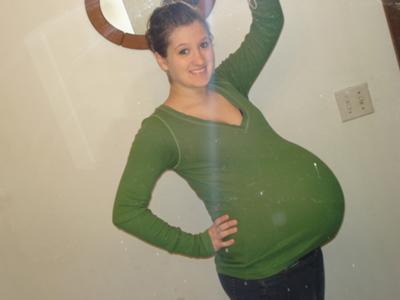Fetal development in pregnancy week 39:
A healthy range of weight is between 5 pounds and 11 ounces and 8 pounds 5 ounces. Your baby is probably somewhere in this range now. The umbilical cord doesn’t have any nerve endings (this means that you and your baby will not feel any pain when it is cut!) and is about 20 inches long and about ½ inch thick. It’s pretty common for the umbilical cord to get knotted at this point, because things are so crowded inside the uterus.
All of your baby’s organs, including the lungs are ready for birth now. Your baby’s immune system is gaining strength at this point. Right now, you are probably very uncomfortable and can hardly stand the wait. Try to take it easy and rest when you can, long naps and reading can help you through the last few days of your pregnancy. Remember that very few babies are born on their due date.
Maternal Changes
At 39 weeks pregnant you will probably be experiencing multiple mood swings, varying from elated to worried to tired and excited. Many women are quite ready for delivery around 39 weeks pregnant. You should keep in mind the emotional roller coaster you are experiencing will continue for a short period of time right after birth.
Immediately following delivery your hormones drop significantly. For some women this causes a bit of distress or a case of the baby blues. In fact roughly 80 percent of women will experience some form or another of the blues after birth. This is however usually very normal and should go away after a short period of time. If you can’t shake your blues however it is important you talk with your doctor. Some women develop a more serious form of the blues called postpartum depression. If you notice after a couple of weeks that you are experiencing excessive anxiety, have long crying jags, feel depression or guilty or feel like you may harm your baby, you should contact your healthcare provider immediately. Postpartum depression can be quite serious, but fortunately there are some simple measures and treatments your doctor can prescribe to help you adjust during this time.
Dad
Have you ever changed a diaper? You might see if there is a baby you can borrow to experiment on. And here is a cheat sheet to see what a new diaper looks like. Seriously, changing diapers is but one thing a dad can do to help a new mom. You can help bathe and snuggle with your baby, consider getting a baby carrier so that you can hold the baby close while you walk around.
Maternity Clothes
Are you an active mom-to-be? Why not look great while working out all at the same time? Fortunately for active mothers, there are wealth of Active Collections at Destination Maternity that move with you and support you before, during and even after your pregnancy.
When shopping Active Collections Dresses at Motherhood Maternity, keep in mind you will need to find clothes made of breathable and stretch fabric. These items will grow with you, move with you and more importantly, and breathe with you while you work out during your pregnancy. Rest assured, most active collections provide extra support particularly for a woman’s chest and belly, the two areas that require the most attention during pregnancy!
Pregnancy Health Tips
Some women will require forceps or vacuum delivery. You might have thought about this by 39 weeks pregnant. While relatively uncommon sometimes a little assistance is needed to help the baby during labor and delivery.

Forceps are an instrument that resemble a pair of tongs. They are sometimes used if the baby isn’t moving into the vaginal canal. This may happen for a number of reasons, but typically occurs if the uterus isn’t contracting well enough to expel the baby. Forceps are sometimes also introduced if the baby has to be delivered quickly because it is in distress.
If you doctor needs to use forceps, he will likely numb your vaginal area and may perform an episiotomy. The forceps are placed on the sides of your baby’s head and used to help pull the baby out. The risks of using forceps when used correctly can be relatively low, but may include bruising or swelling on your baby’s head and scalp.
In other cases, your doctor may need to use a vacuum extractor. This is a device that is shaped like a cup. It is placed on top of your baby’ head. The vacuum extractor applies a gentle suction to the top of the baby’s head to help pull your baby out of the birth canal. This can help prevent the baby’s head from being pushed back up the birth canal in between contractions. Bruising or swelling might also occur when a vacuum extractor is used.
In most instances, neither of these instruments will need to be used, but there is always a small possibility. If you have any concerns be sure to check with your doctor prior to labor and delivery. They can help explain the risks and potential need to you in greater detail.
Twin Tips
Are you tired of answering questions about still being pregnant? Not much longer. Your weekly check ups probably include non-stress tests to help ensure babies are growing well and that the placentas are not aging. Remember to ask any questions you have during your visits. If you have poor memory, write them down before you go and record the answers on the same paper!

